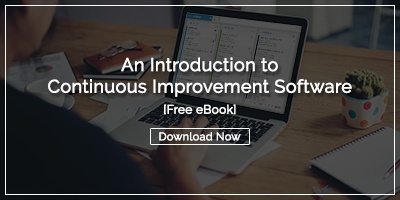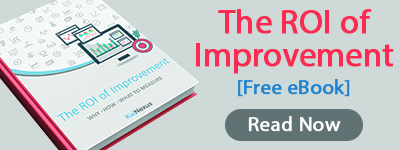 I can always tell when the end of the year is coming up because visits to my website and requests for demos skyrocket.
I can always tell when the end of the year is coming up because visits to my website and requests for demos skyrocket.
Why?
My running theory is that people are evaluating their performance in 2017 and planning strategies for achieving their 2018 goals. It’s natural for continuous improvement software to come up at this time of the year, as people start to realize that they’re struggling to quantify their impact and need a solution so they’re not in the same boat next year.
Let’s take a look at how continuous improvement software makes this easier.
- Know How You Did as a Coach
As a person who is interested in process improvement, being able to evaluate your own job performance is likely of interest to you. You need to know how successfully you spread improvement and the impact those efforts have achieved. Thinking of that objectively can be tough without the data to back it up - and traditional improvement tracking systems don’t help you figure out what you need to know to evaluate your coaching.
Improvement software, on the other hand, gives clear insights into the health of your improvement organization and the impact you’ve had on it. You can easily see how the engagement rate of employees in your organization has changed over time, evaluate the activity levels through each department, and you have clear visibility into the impact of every improvement, person, project, and department.
Comparing these stats year-over-year is simple, and because it’s all logged in a standard, uniform way, you know you’re always comparing apples to apples. - Evaluate Trends
You know that expression about having to know where you stand to know where you’re going? That applies to continuous improvement, too. You need to know your current state in order to predict where you can expect to take your improvement culture next year.
Continuous improvement software lets you track engagement, activity, and impact in clear, filterable reports that show exactly the details you need to make granular predictions and set achievable goals. - Validate Your Existence
Ok, hopefully, you’ve got other things going on in your life that validate your existence… maybe I should have titled this section “Validate Your Position.” If your company is like most organizations, money is tight and everyone's competing for budget increases year-over-year. The last thing you want is for your leadership team to think that the process improvement department is a fluffy, nice-to-have area rather than the hard-hitting Lean machine that you really are.
Improvement software ensures that you have reliable ROI data to share, covering cost savings, time savings, and revenue generation in extraordinary detail that can easily be validated by your finance department. When you can prove that your team has had an impact of $2M in the last 12 months, asking for a $6K budget increase to add improvement software to the mix doesn’t seem so bad, does it? - Present Your Work
Do you know what I hate? Making Powerpoint presentations. That’s why, here at KaiNexus, when we want to show someone what we’re working on, our progress, and our KPIs, we just open up KaiNexus instead of painstakingly building reports and slides.
Continuous improvement software enables you to show executives the reports they care about in real time, without wasting time formatting slides and keeping them up-to-date. You can just log in and show your impact metrics, engagement scores, project statuses, and whatever else they care about. - Identify Improvements Contributing to Organizational Strategy
It’s one thing to tell your boss that the improvement work your team is doing is furthering the organization’s strategic goals; it’s another to show her. Improvement software enables every improvement to be tied to the strategic initiatives to which it relates so that you can track the activity and impact that your executives care about. Technology makes it easy to see who is working on initiatives addressing strategic goals, to drill down into the details of any project, and prove the impact you’re having.
These are just some of the reasons that the need for continuous improvement software becomes strikingly apparent at the end of the year. Learn about the ROI of improvement software in this newly updated eBook:



Add a Comment